

Dead Bug Exercise: 5 Variations
The Dead Bug Exercise is a popular ab exercise with several variations. This core move went viral as an effective way to strengthen ab muscles (spoiler: it works better than crunches). Read on for everything you need to know about the dead bug exercise, including how to do it with proper form, benefits and variations.
Although it might have a silly name, the dead bug exercise is no joke when it comes to effective core training.
This one exercise targets multiple muscle groups between your hips and shoulders, hitting the:
- Erector spinae (lower back muscles)
- Obliques (muscles along the sides of the body)
- Rectus abdominis (“six-pack” muscles)
- Transverse abdominis (deep core muscles)
- Posterior and anterior deltoids (back muscles)
The dead bug exercise strengthens the core to do what it’s actually intended to do: stabilize the trunk of the body when the limbs extend away from the body.
This is an extremely functional core movement. Think of all the times you reach overhead to put something away, or step up with one leg to climb stairs. The core works to stabilize your body through these types of movements.
The dead bug is also a great exercise for rebuilding core strength postpartum – you’ll find the beginner version of a dead bug in many of our diastasis recti workouts.

Dead Bug Exercise: How To and 5 Variations
Build strength in the total core with these 5 Dead Bug Exercise Variations – combined in one fun and challenging no repeats workout.
These dead bug exercises can be scaled from beginner to advanced to build core strength and definition, improve posture, and reduce lower back pain.
Add this dead bug workout to your workout routine as you feel capable, starting with 1-2 times a week and scaling up to 3-4 times a week. I recommend alternating this workout with our other core workout videos to avoid workout boredom.
Workout Equipment:
Medium Set of Dumbbells.
I recommend between 5-15 lbs depending on your fitness level. We used 10 and 15 lb dumbbells in today’s workout. Option to drop weights at any time and do this workout with just your bodyweight.
Workout Instructions:
Follow along with the guided Dead Bug Workout on YouTube, led by certified personal trainer and certified fitness instructor, Lindsey Bomgren.
Your Workout Looks Like This:
- 5 Dead Bug Exercise Variations
- Timed Intervals (40 seconds of work, 20 seconds rest; complete as many reps as you can in the timed interval)
- Perform Each Exercise x1 (No Repeats)
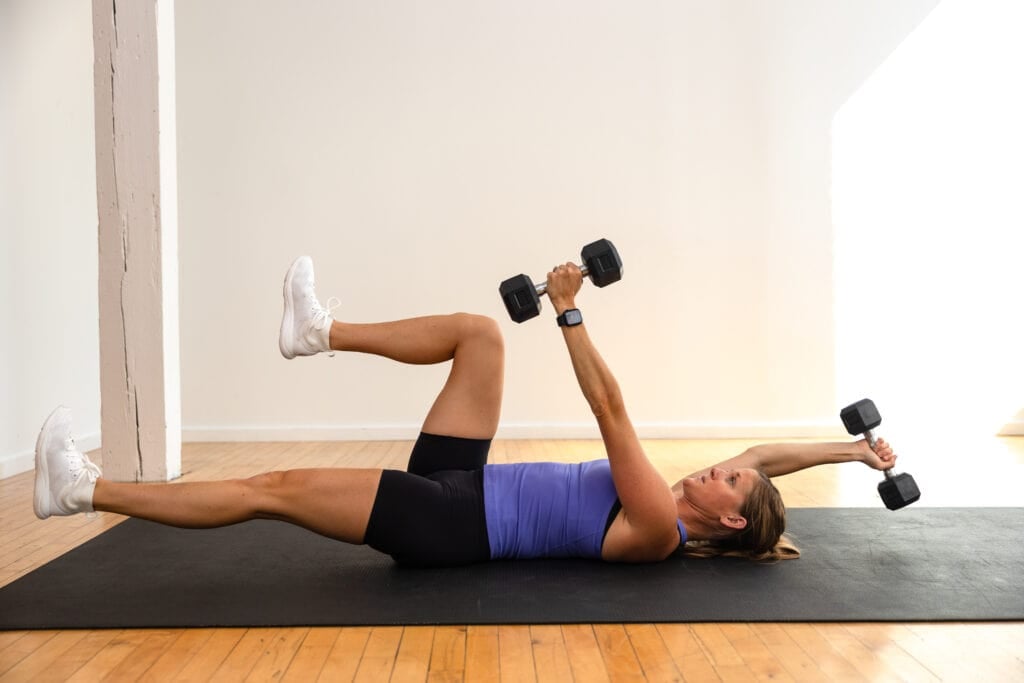
Prefer to Watch On YouTube?
Workout Outline
- Dead Bug
- Single Sided Dead Bug
- Dumbbell Dead Bug
- Double Arm Dead Bug
- Straight Leg Dead Bug
5 Dead Bug Exercise Variations
Dead Bug
Targets: Transverse abdomen (deep core muscles below your rectus abdomen or six pack ab muscles), lower abs and hip flexors.
This is the most basic beginner version of the dead bug: extending opposite arm and leg away from the body as the trunk remains stable.

How To Do A Dead Bug
- Lie flat on the mat, performing a slight pelvic tilt to press your lower back into the mat and drawing your belly button towards your spine. Think about wrapping your abdominal wall around your torso.
- Then bring your arms and legs up, knees bent at 90 degrees, shins parallel to the floor. Arms extended straight overhead, wrists stacked over shoulders.
- Contract your ab muscles to engage your core as you extend your right arm overhead while simultaneously straightening your left leg. Return to the starting position.
- Then extend your left arm overhead while simultaneously straightening your right leg. Return to the starting position and repeat.
Modification: Reduce range of motion to reduce the intensity. You can keep bends in both knees rather than kicking straight out to scale this exercise as well.
Single Sided Dead Bug
Targets: Transverse abdominal muscles (deep core muscles below your rectus abdominis muscle or six pack ab muscles), lower abs, inner thighs and hip flexors.

How To Do A Single Sided Dead Bug
- Lie on your back flat on the floor, performing a slight pelvic tilt to press your lower back into the mat.
- Lift your knees to form a 90-degree angle (knees stacked on top of hips), and extend your hands straight overhead toward the ceiling. Inhale, letting your belly expand.
- Exhale, engaging your core and simultaneously extending your right arm and left leg away from your body. Left arm and right leg remain in place. With control, return to starting position.
- Repeat for 20 seconds, moving just the right arm and left leg. Then switch for the remaining 20 seconds, repeating with just the left arm and right leg.
Modification: Reduce range of motion of your legs, performing bent leg dead bugs instead of straight leg dead bugs to reduce the intensity of this exercise.
Dumbbell Dead Bug
Targets: Deep core muscles (transverse abdominis), lower abs, hips, shoulders and back (posterior and anterior deltoids).
Adding a dumbbell is one of my favorite ways to strength train the core muscles.

How To Do Weighted Dead Bugs
- Lie on your back flat on the floor, performing a slight pelvic tilt to press your lower back into the mat. Lift your knees to form a 90-degree angle (knees stacked on top of hips).
- Hold a dumbbell in each hand and extend your hands straight overhead toward the ceiling. Inhale, letting your belly expand.
- Exhale, engaging your core and simultaneously extending your left leg and right arm away from your body, lowering the dumbbell in your right arm towards the ground with control. Left arm and right leg remain in place. With control, inhale as you return to starting position.
- Then repeat on the opposite side, exhaling as you extend your right leg and left arm away from the body, lowering the dumbbell in your left arm towards the ground. With control, return to starting position.
Modification: Reduce range of motion of your legs, performing bent leg dead bugs instead of straight leg dead bugs to reduce the intensity of this exercise. Use lighter weights or a filled water bottle if the dumbbell variation is too intense. You can also try adding a resistance band rather than dumbbells.
Double Arm Dead Bug
Targets: Deep core muscles (transverse abdominis), lower abs, hips, shoulders and back (posterior and anterior deltoids).
Moving both arms (versus one single arm) makes this move more challenging and requires more core engagement. Focus on keeping your lower back pressed into the ground and hips even.

How To Do Double Arm Dead Bugs
- Lie on your back flat on the floor, performing a slight pelvic tilt to press your lower back into the mat. Lift your knees to form a 90-degree angle (knees stacked on top of hips).
- Hold a dumbbell horizontally between your hands, and extend your arms straight overhead toward the ceiling. Inhale, letting your belly expand.
- Exhale, engaging your core and simultaneously extending your left leg and both arms away from your body, lowering the dumbbell towards the ground with control. With control, inhale as you return to starting position.
- Then repeat on the opposite leg, exhaling as you extend your right leg and both arms away from the body, lowering the dumbbell towards the ground. With control, return to starting position.
Modification: Reduce range of motion of your legs, performing bent leg dead bugs instead of straight leg dead bugs to reduce the intensity of this exercise. Use lighter weights or a filled water bottle if the dumbbell variation is too intense.
Straight Leg Dead Bug
Targets: Deep core muscles (transverse abdominis), lower abs, hips, shoulders and back (posterior and anterior deltoids).
Straightening your legs is one way to increase the intensity of the dead bug exercise. The “longer lever” requires more core control throughout the movement.
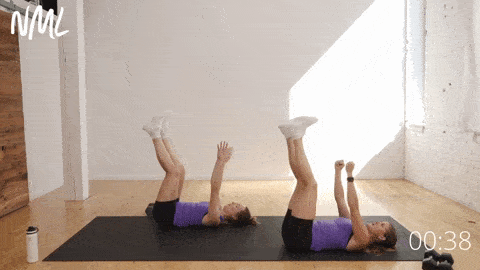
How To Do A Straight Leg Dead Bug
- Lie flat on the mat, performing a slight pelvic tilt to press your lower back into the mat and drawing your belly button towards your spine. Think about wrapping your abdominal wall around your torso.
- Then bring your legs up, knees stacked over hips and legs extended straight overhead. Extend your arms straight overhead, wrists stacked over shoulders.
- Contract your ab muscles as you extend your right arm overhead while simultaneously extending your left leg away from the body. Keep both legs as straight as possible throughout the entire movement. With control, return to the starting position.
- Then extend your left arm overhead while extending your right leg out away from the body. Return to the starting position.
Modification: Reduce range of motion to reduce the intensity. You can keep bends in one or both knees rather than kicking straight out to scale this exercise as well.
Dead Bug Exercise FAQs
The dead bug exercise works every muscle in the core. This includes the transverse abdominis (deep core muscles that wrap around you like a corset), rectus abdominis ( or “six-pack” muscles), obliques (muscles on the sides of your core), back, shoulders and pelvic floor.
The most basic version of the dead bug is done with your bodyweight. It’s a great option for beginners who are are focusing on building core strength. Start with beginner variations and scale up to more advanced versions when you feel ready.
Dead bugs are a great ab exercise to master before advancing to planks. Dead bugs strengthen the stabilization muscles along your spine and core in a more controlled position (lying on your back) compared to a plank. This helps avoid common plank form mistakes (like a dipped lower back) that can lead to pain.
The dead bug exercise is an effective way to build core strength and core stability with a low risk of injury. The dead bug is an anti-extension movement, which means you’ll focus on keeping your lower back flattened into the mat as your limbs reach away. Practicing this neutral spinal position can help improve posture and reduce lower back pain as an added bonus.
More Workouts
Abs + Core WorkoutsPin This Workout: Dead Bug Exercise: Tutorial and Variations
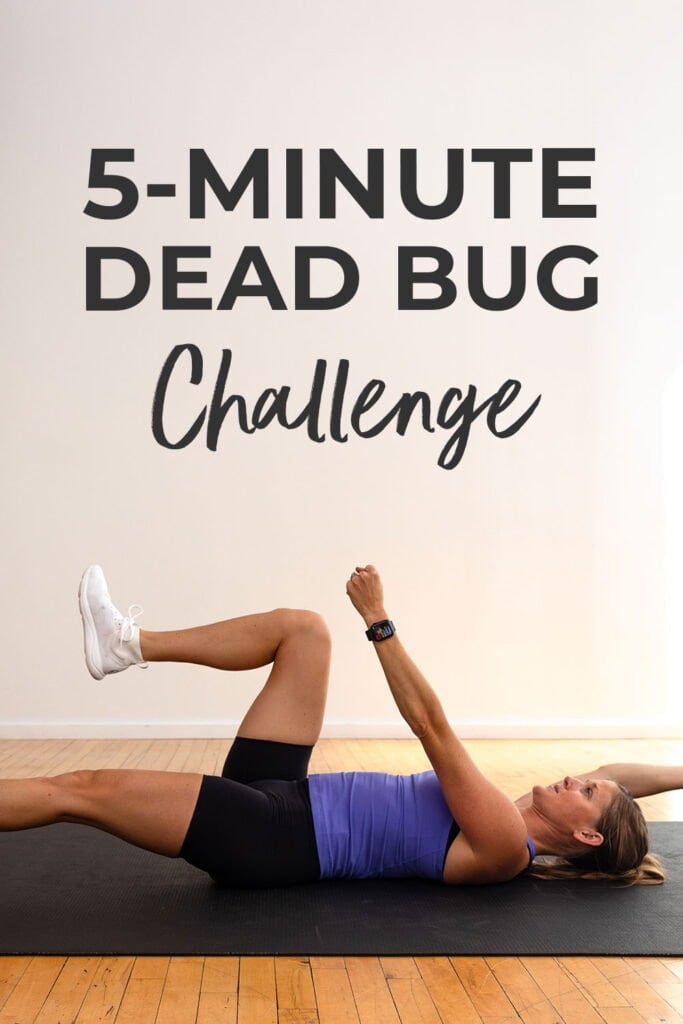
This post includes affiliate links. I do earn a commission for products purchased using these links (at no additional cost to you). Thank you for supporting Nourish Move Love, making the content you see on this blog possible.










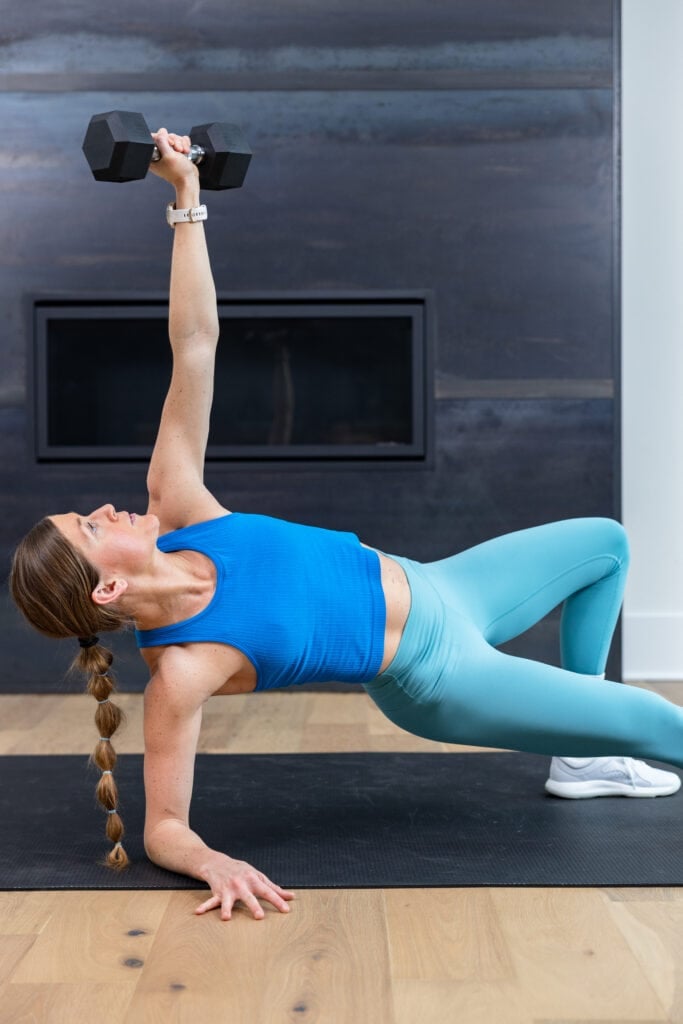




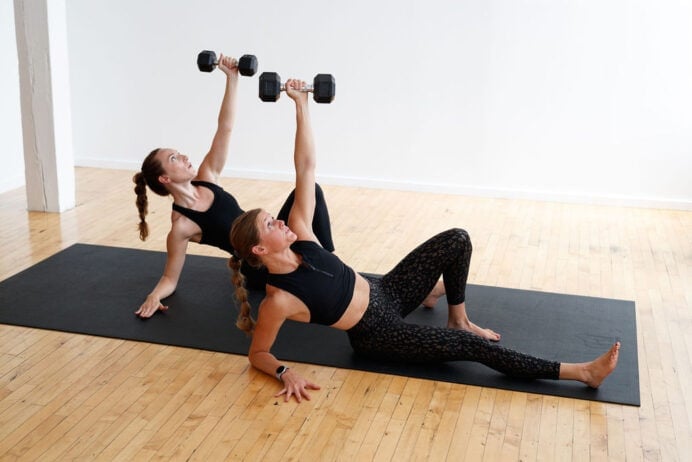







Is it normal to feel the dead bug in your quads too? Or am I doing something wrong?
I would say more so in your hips/hip flexors — that’s normal. But you’ll certainly be flexing your quad as you extend your leg away from your body! If it’s too much you could always shorten the leg extension and bend at the knees. I hope that helps! Lindsey
I absolutely LOVED this challenge. I did this yesterday, once before the recommended arms + back workout and once right after. My core is still burning in the best way possible! I am planning on doing this challenge after every workout for the next few weeks to see the results. Thank you NML!
Fatima! SO glad you loved this dead bug exercise challenge! It’s a great add on to any workout! Keep up the great work – Lindsey
Do you have any pregnancy-friendly modifications for this when you can’t lay flat on your back anymore? I tried doing it from a seated position (similar to a boat pose), and man, that was tough, even just with bodyweight!
Hi Jessie! Congrats on your pregnancy! I suggest substituting bird dog for dead bug when pregnant! But you might also want to check out our Safe Core Exercises (3rd Tri) – https://www.nourishmovelove.com/6-prenatal-core-exercises/. Or Pregnancy Abs (2nd Tri) – https://www.nourishmovelove.com/pregnancy-ab-exercises/! I hope that helps! -Lindsey